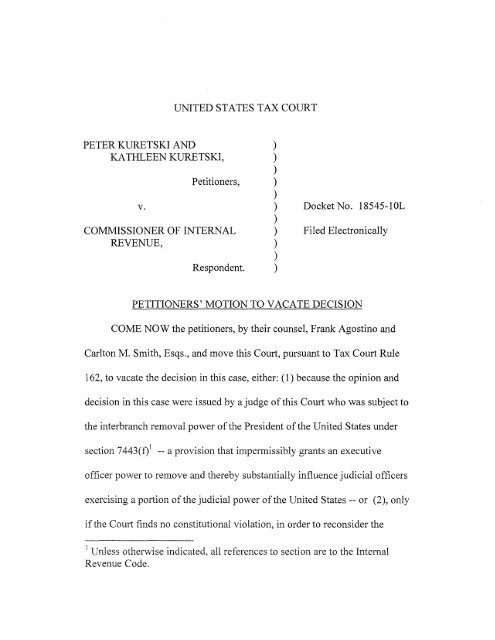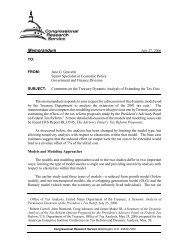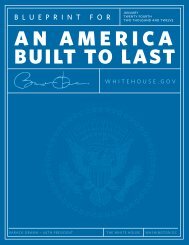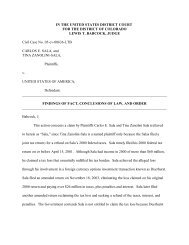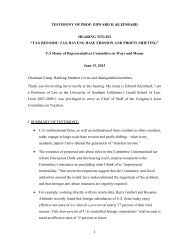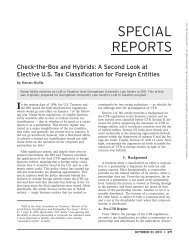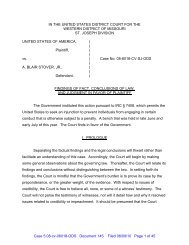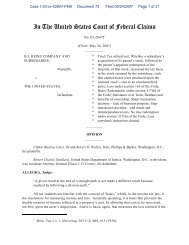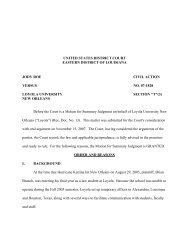motion to vacate
motion to vacate
motion to vacate
Create successful ePaper yourself
Turn your PDF publications into a flip-book with our unique Google optimized e-Paper software.
UNITED STATES TAX COURT<br />
PETER KURETSKI AND<br />
KATHLEEN KURETSKI,<br />
v.<br />
Petitioners,<br />
COMMISSIONER OF INTERNAL<br />
REVENUE,<br />
Respondent.<br />
)<br />
)<br />
)<br />
)<br />
)<br />
)<br />
)<br />
)<br />
)<br />
)<br />
)<br />
Docket No. 18545-10L<br />
Filed Electronically<br />
PETITIONERS' MOTION TO VACATE DECISION<br />
COME NOW the petitioners, by their counsel, Frank Agostino and<br />
Carl<strong>to</strong>n M. Smith, Esqs., and move this Court, pursuant <strong>to</strong> Tax Court Rule<br />
162, <strong>to</strong> <strong>vacate</strong> the decision in this case, either: (1) because the opinion and<br />
decision in this case were issued by a judge ofthis Court who was subject <strong>to</strong><br />
the interbranch removal power ofthe President ofthe United States under<br />
section 7443(f)1 -- a provision that impermissibly grants an executive<br />
officer power <strong>to</strong> remove and thereby substantially influence judicial officers<br />
exercising a portion ofthe judicial power ofthe United States -- or (2), only<br />
ifthe Court finds no constitutional violation, in order <strong>to</strong> reconsider the<br />
j Unless otherwise indicated, ali references <strong>to</strong> section are <strong>to</strong> the Internal<br />
Revenue Code.
opinion in this case under the <strong>motion</strong> for reconsideration ofthe opinion filed<br />
simultaneously herewith (for the reasons stated in that <strong>motion</strong>f Ifthis<br />
<strong>motion</strong> is granted on the constitutional ground, petitioners do not request a<br />
new trial or additional briefing, but request that, after the Court declares that<br />
its judges are not subject <strong>to</strong> the removal power and thus are no longer<br />
potentially substantially influenced by the improper threat ofinterbranch<br />
removal, the Court decide this case once again, ab initio, on the record and<br />
briefing previously submitted and consider all legal and factual arguments<br />
made in the <strong>motion</strong> for reconsideration as ifthey were made in the<br />
petitioners' opening brief- i.e., not under the standards applicable <strong>to</strong><br />
<strong>motion</strong>s for reconsideration ofopinion, but under standards ofwhat may be<br />
argued in opening briefs.<br />
IN SUPPORT OF THIS MOTION, the petitioners show as follows:<br />
1. In 1924, Congress established the Board ofTax Appeals (the<br />
"Board") as "an independent agency in the executive branch of<br />
Government." Revenue Act of 1924, ch. 234, sec. 900(k), 43 Stat. 338.<br />
Congress authorized the President <strong>to</strong> appoint members ofthe Board with the<br />
advice and consent ofthe Senate - in accordance with the procedures for<br />
principal Officers ofthe United States required by the Appointments Clause<br />
2 John P. L. Miscione, Esq. and Professor Tuan Samahon, Esq. assisted in drafting this <strong>motion</strong>. Both<br />
expect <strong>to</strong> enter appearances in this matter presently.<br />
2
ofthe Constitution (Art. II, sec. 2, cl. 2). Id., at sec. 900(b), 43 Stat. 336.<br />
After initial two-year terms ofoffice, Congress authorized the President <strong>to</strong><br />
appoint successor Board members eventually having 10-year terms ofoffice.<br />
Id., 43 Stat. 336-337. Without any public hearing, Board members could be<br />
removed by the President for "inefficiency, neglect ofduty, or malfeasance<br />
in office, but for no other reason". Id., 43 Stat. 337.<br />
2. In 1926, Congress amended Title IX ofthe Revenue Act of<br />
1924 <strong>to</strong> provide, at section 900, that the Board "is hereby continued as an<br />
independent agency in the Executive Branch ofthe Government". Revenue<br />
Act of 1926, ch. 27, sec. 1000,44 Stat. 105-106. Congress also at that time<br />
altered the normal term ofoffice ofBoard members <strong>to</strong> 12 years; id., at sec.<br />
901 (b), 44 Stat. 106; and inserted in<strong>to</strong> the removal provision a requirement<br />
that there be a public hearing before a member could be removed. Id., at<br />
sec. 901(a), 44 Stat. 106.<br />
3. Without any change in the removal language, section 11 02(±) of<br />
the Internal Revenue Code of 1939 provided that members ofthe Board<br />
"may be removed by the President, after notice and opportunity for public<br />
hearing, for inefficiency, neglect ofduty, or malfeasance in office, but for no<br />
other cause." Pub. Act No.1, 76 th Cong, 53 Stat. 159. Section 1100 ofthe<br />
3
1939 Code stated that the Board "shall be continued as an independent<br />
agency in the Executive Branch ofthe Government." Id., 53 Stat. 158.<br />
4. In 1942, Congress renamed the Board ofTax Appeals the Tax<br />
Court ofthe United States, but kept it in the Executive Branch. Pub. L. 752,<br />
7t h Cong., ch. 618, sec. 504, 56 Stat. 957.<br />
5. The Internal Revenue Code of 1954 renumbered these 1939<br />
Code provisions, but did not change their text. Section 7441 ofthe 1954<br />
Code provided, in part: "The Board ofTax Appeals shall be continued as an<br />
independent agency in the Executive Branch ofthe Government, and shall<br />
be known as the Tax Court ofthe United States." Pub. L. 59, 83 rd Cong., ch<br />
736, 68A Stat. 879. Section 7443(f) ofthe 1954 Code provided: "Judges of<br />
the Tax Court may be removed by the President for inefficiency, neglect of<br />
duty, or malfeasance in office, but for no other cause." Id. Section 7443(f)<br />
has not undergone any amendment since 1954.<br />
6. In 1969, Congress amended section 7441 <strong>to</strong> provide, in part:<br />
"There is hereby established, under article I ofthe Constitution ofthe United<br />
States, a comt ofrecord <strong>to</strong> be known as the United States Tax COUlt." Pub.<br />
L. 91-172, sec. 951, 83 Stat. 730. At the same time, Congress changed the<br />
term of office ofTax COUli judges <strong>to</strong> 15 years. Id., at sec. 952(b), 83 Stat.<br />
730. "It is clear from the statu<strong>to</strong>ry language and the Senate committee<br />
4
eport (S. Rept. No. 91-552, 91st Cong., 1st Sess., p. 302, 1969-3 e.B. 614)<br />
that Congress removed the Tax Court from the Executive Branch and<br />
established it as an article I court primarily for the purpose ofrecognizing its<br />
status as a judicial body and disposing ofany problems that its status as an<br />
executive agency sitting in judgment on another executive agency might<br />
pose." Burns, Stix Friedman & Co. v. Commissioner, 57 T.e. 392, 395<br />
(1971).<br />
7. In Burns, the Tax Court held that even though it was not an<br />
Article III court, (1) it was a legislative court that did not violate the<br />
Constitution when it exercised "judicial power", and (2) Congress had not<br />
exceeded its constitutional power in assigning "judicial power" <strong>to</strong> the Tax<br />
Court.<br />
8. Freytag v. Commissioner, 501 U.S. 868 (1991), presented the<br />
Supreme Court with a question concerning the "excepting" provision ofthe<br />
Appointments Clause. Under that Clause, Congress may opt out of<br />
presidential nomination and Senate confirmation in the appointment of<br />
inferior officers, and, in tum, vest that power in the President alone, in the<br />
"Heads of [Executive] Departments", or in "the Courts ofLaw". The issue<br />
was whether Congress could constitutionally vest the Tax Court ChiefJudge<br />
with the power <strong>to</strong> appoint Tax Court Special Trial Judges ("5TJs"). The<br />
5
Court readily held that STJs were "inferior Officers", amenable <strong>to</strong> opting<br />
out, but then had <strong>to</strong> decide whether the ChiefJudge ofthe Tax Court was a<br />
head ofan Executive "Department" or a member of"the Courts ofLaw."<br />
The Court interpreted "Heads ofDepartments" <strong>to</strong> encompass only cabinetlevel<br />
Executive Departments 3 -<br />
and that the Tax Court was not such a<br />
Department. Instead, the Court concluded that the Tax COUli exercised "the<br />
judicial power ofthe United States", and accordingly was a part of"the<br />
Courts ofLaw" contemplated by the Clause. Since the Tax Court was one<br />
ofthe Courts ofLaw, its ChiefJudge could validly appoint its STJs<br />
unembarrassed by the limits ofthe clause.<br />
9. In order <strong>to</strong> decide in which branch ofgovernment the Tax Court<br />
belonged for the Appointments Clause analysis, the Freytag majority and the<br />
concurring justices debated the characterization ofthe Tax Court's power.<br />
The Supreme Court, by a 5-4 vote, concluded that the Tax Court exercises<br />
3 The Supreme Court in Freytag reserved the question whether certain other<br />
agencies ofthe government, such as the Federal Trade Commission and the<br />
Securities and Exchange Commission could be "Departments" under the<br />
Appointments Clause. Id., at 887 n. 4. In Free Enterprise Fund v. Public<br />
Company Accounting Oversight Board, 130 S. Ct. 3138, 3162-3163 (2010),<br />
the Supreme Court resolved that question by holding that the Securities<br />
Exchange Commission could be a "Department" because it was a<br />
freestanding component ofthe Executive Branch not subordinate <strong>to</strong> or<br />
contained within any other such component. In resolving the issue, the<br />
Court adopted the reasoning ofJustice Scalia's concurrence on this issue in<br />
Freytag.<br />
6
"the judicial power ofthe United States". "The Tax Court exercises judicial,<br />
rather than executive, legislative, or administrative, power. It was<br />
established by Congress <strong>to</strong> interpret and apply the Internal Revenue Code in<br />
disputes between taxpayers and the Government. By resolving these<br />
disputes, the court exercises a portion ofthe judicial power ofthe United<br />
States." Id., at 890-891 (emphasis added).<br />
10. Justice Scalia disagreed that the Tax Court could be considered<br />
one of"the Courts ofLaw" and concurred separately. One reason he<br />
concluded the Tax Court could not be judicial was that its judges "are still<br />
removable by the President for 'inefficiency, neglect ofduty, or malfeasance<br />
in office.'" Id., at 912 (Scalia, J., concurring). He then noted parenthetically<br />
that "[i]n Bowsher v. Synar ... we held that these latter terms are 'very<br />
broad' and 'could sustain removal ... for any number ofactual or perceived<br />
transgressions'" and questioned "[h]ow anyone with these characteristics can<br />
exercise judicial power'independent ... [of] the Executive Branch' fl.<br />
Id.<br />
eemphasis in original). Justice Scalia lost the vote that the Tax Court<br />
exercises judicial power, but his trenchant observation in dicta about<br />
executive removal power over judicial officers carries continued<br />
constitutional significance. Freytag concerned only appointment power, not<br />
removal power. Accordingly, the Freytag parties did not raise, and Frevtag<br />
7
did not decide, whether the President could continue <strong>to</strong> hold removal<br />
authority over Tax Court judges. This <strong>motion</strong> is directed at resolving the<br />
tension between the Freytag majority's holding that the Tax Court exercises<br />
the judicial power (on the one hand) and the President's continuing statu<strong>to</strong>ry<br />
power <strong>to</strong> remove the Tax Court judges (on the other). This <strong>motion</strong> proposes<br />
resolving that tension by ousting the President from this Court's exercise of<br />
the judicial power ofthe United States in order <strong>to</strong> make the exercise ofits<br />
power more appropriately independent ofexecutive duress.<br />
11. As Justice Scalia suggested, Bowsher v. Synar, 478 U.S. 714<br />
(1986), is the key controlling case for assessing the validity ofthe actions of<br />
Tax Court judges in light ofa presidential "for cause;; removal power. In<br />
Bowsher, the 1985 Balanced Budget and Emergency Deficit Control Act<br />
assigned executive functions <strong>to</strong> the Comptroller General, an officer<br />
removable by Congress upon a joint resolution finding inefficiency, neglect<br />
ofduty, or malfeasance. 31 U.S.c. § 703(e)(l)(B). The Court disallowed<br />
this interbranch removal power as violating the separation ofpowers. The<br />
legislative branch impermissibly held a statu<strong>to</strong>ry "for cause" removal power<br />
against an officer exercising executive power. The Court agreed that, even<br />
though the Act purported <strong>to</strong> limit congressional power <strong>to</strong> remove the<br />
Comptroller General for inefficiency, neglect ofduty, or malfeasance, the<br />
8
Comptroller General would reasonably be concerned as a practical matter<br />
for removal virtually on any ground.<br />
To pennit an officer controlled by Congress <strong>to</strong> execute the laws would<br />
be, in essence, <strong>to</strong> pennit a congressional ve<strong>to</strong>. Congress could simply<br />
remove, or threaten <strong>to</strong> remove, an officer for executing the laws in any<br />
fashion found <strong>to</strong> be unsatisfac<strong>to</strong>ry <strong>to</strong> Congress. This kind of<br />
congressional control over the execution ofthe laws ... is<br />
constitutionally impermissible.<br />
Bowsher, 478 U.S. at 726-727 (emphasis added). Authorizing a branch <strong>to</strong><br />
remove an officer exercising another branch's power (and thereby<br />
controlling it) is unconstitutional.<br />
12. Bowsher rejected any argument that Congress' removal power,<br />
and thereby control, was significantly limited by the "for cause" grounds of<br />
inefficiency, neglect ofduty, or malfeasance. As the COUli noted, "[t]hese<br />
terms are very broad and, as interpreted by Congress, could sustain removal<br />
ofa Comptroller General for any number ofactual or perceived<br />
transgressions ofthe legislative will." Id., at 729. The Court anticipated that<br />
the troublesome Bowsher-type arrangement could be extended <strong>to</strong> other<br />
interbranch removals and would prove equally objectionable. "Surely no<br />
one would seriously suggest that judicial independence would be<br />
strengthened by allowing removal offederal judges only by a joint<br />
resolution tInding 'inefficiency,' 'neglect ofduty,' or 'malfeasance. '"<br />
Id., at<br />
730.<br />
9
13. The impennissible Bowsher arrangement is virtually identical<br />
<strong>to</strong> the one Congress has legislated in Internal Revenue Code section 7443(1)<br />
with respect <strong>to</strong> Tax Court judges. Under section 7443(f), "Judges ofthe Tax<br />
Court may be removed by the President for inefficiency, neglect ofduty, or<br />
malfeasance in office, but for no other cause" - the very three "for cause"<br />
reasons that Bowsher warned could be used by Congress against the<br />
Comptroller General "for any number ofactual or perceived transgressions<br />
ofthe legislative will". 478 U.S. at 729. Thus, <strong>to</strong> paraphrase Bowsher, the<br />
President could use these removal power reasons against Tax Court judges<br />
"for any number ofactual or perceived transgressions ofthe [Executive]<br />
will". Ifthe Tax Court were still an Executive-Branch agency, as it was<br />
when originally founded as the Board ofTax Appeals in 1924, an executive<br />
removal power would not present a separation ofpowers problem. Indeed,<br />
executive removal power may best be unders<strong>to</strong>od as a statu<strong>to</strong>ry vestigial<br />
remnant ofthe Tax Court's prior status as an Executive Branch unit. But,<br />
since Freytag's 1991 holding that the Tax Court currently exercises the<br />
judicial power, the President's right <strong>to</strong> remove a Tax Court judge for these<br />
reasons represents the same removal power repugnant <strong>to</strong> the separation of<br />
powers as the interbranch removal power in Bowsher.<br />
10
14. In the alternative, even ifthe Tax Court had not been found <strong>to</strong><br />
hold the judicial power, the Tax Court is now, since 1969, an Article I court.<br />
Ifthe interbranch removal power is not one ofthe Executive interfering with<br />
the judicial power, in the alternative, it is the Executive interfering with the<br />
legislative branch. The Tax Court is in no case currently an Executive<br />
agency. That argument was specifically rejected in reaching the holding in<br />
Freytag.<br />
15. How serious is the removal power ofTax Court judges?<br />
Although there is no instance in which the President has removed as such a<br />
Tax Court judge under section 7443(f) or its predecessor statutes, the<br />
President's power can be used <strong>to</strong> precipitate a Tax Court judge's resignation.<br />
More seriously, the President need not threaten removal at all <strong>to</strong> taint the<br />
exercise ofthe Tax Court's judicial power. The bare existence ofa<br />
presidential removal power chills or disciplines the Tax Court judges in their<br />
exercise ofjudicial authority. The fear ofreprisal grants the President<br />
impermissible power <strong>to</strong> control judicial officers.<br />
16. Over the years, some Tax Court judges have been known<br />
privately <strong>to</strong> express concern that they could be removed for "inefficiency" or<br />
"neglect ofduty" - at least ifthey did not keep up production ofopinions at<br />
a rate <strong>to</strong> the President's liking.<br />
11
17. This interbranch removal power creates an institutional<br />
unleveled playing field that simply cannot be countenanced under the<br />
Supreme Court's separation-of-powers jurisprudence and should not be<br />
endured by the Tax Court judges - or its taxpayer litigants.<br />
18. There has been at least one recent public instance of agitation<br />
for the President <strong>to</strong> remove a Tax Court judge: In 2010, Lanny Davis,<br />
counsel for the aggrieved Kanter plaintiffs in Ballard v. Commissioner, 544<br />
U.S. 40 (2005), petitioned President Obama <strong>to</strong> institute an investigation of<br />
Senior Tax Court Judge Howard A. Dawson, Jr. with the object ofpossibly<br />
removing him. 4<br />
To date, Judge Dawson has not been removed. Ban-ing a<br />
transparent and formal process, however, it would be difficult <strong>to</strong> determine if<br />
any Tax Court judge negotiated a quiet removal by way ofresignation in lieu<br />
ofa potentially public spectacle. Whether any prior administration may<br />
have precipitated resignations ofTax Court judges, or entertained refen-als<br />
proposing such a course ofaction, is not a matter detailed in any generally<br />
available public record.<br />
19. The interbranch removal problem at stake here is uncommon.<br />
While there are a number ofadjudica<strong>to</strong>ry independent agencies like the Tax<br />
4 "[W]e call on the president, who has the power <strong>to</strong> remove a Tax Court<br />
judge, <strong>to</strong> immediately institute an investigation on whether such removal is<br />
justified." Sam Young, "Kanter Plaintiffs Call for Investigation ofTax Court<br />
Judges", Tax Notes Today, Mar. 8,2010, at 1181,2010 TNT 44-1.<br />
12
Court, few have been found <strong>to</strong> hold the judicial power ofthe United States. 5<br />
The former Court ofClaims, which similarly was an Article I court, also<br />
exercised the judicial power. Freytag, supra, at 899-890 (citing Williams v.<br />
United States, 289 U.S. 553,565-567 (1933)). The Court ofFederal Claims,<br />
its successor, is also organized as a court ofrecord under Article I ofthe<br />
Constitution. 28 U.S.C. § 171(a). The President cannot remove that Court's<br />
judges. 28 U.S.C. § 176(a). Tellingly, those judges can be removed for<br />
cause by only the judicial officers ofthe Federal Circuit. Id. Thus, the<br />
Court ofFederal Claims does not suffer from a similar interbranch removal<br />
problem, as an Article III court's judges 6 can remove Court ofFederal<br />
Claims judges without presenting any issue ofinterbranch control.<br />
20. Nor are independent agencies that are only "quasi-judicial" or<br />
"quasi-legislative" subject <strong>to</strong> the same interbranch removal problem when<br />
the President holds a "for cause" removal power over their members. 7<br />
The<br />
5 For example, terri<strong>to</strong>rial courts do not exercise the judicial power ofthe<br />
United States, as they are "incapable ofreceiving the judicial power<br />
conferred by the Constitution", McAllister v. United States, 141 U.S. 174,<br />
190 (1891).<br />
6 The Federal Circuit's judges are Article III judges. 28 U.S.C. §§ 41 and<br />
43.<br />
7 Justice Jackson once tellingly observed that "Courts have differed in<br />
assigning a place <strong>to</strong> these seemingly necessary bodies in our constitutional<br />
system. Administrative agencies have been called quasi-legislative, quasiexecutive,<br />
or quasi-judicial, as the occasion required, in order <strong>to</strong> validate<br />
their functions within the separation ofpowers scheme ofthe Constitution.<br />
13
Supreme Court has not stated that such agencies "exercise the judicial power<br />
ofthe United States;" these agencies decide cases in the manner ofjudgesi.e.,<br />
case-by-case adjudication - but actually exercise only executive power.<br />
Freytag, supra, at 911 (Scalia, 1., concurring). In Freytag, the Supreme<br />
Court noted that "[t]he Tax Court's exclusively judicial role distinguishes it<br />
from other non-Article III tribunals that perfonn multiple functions and<br />
provides the limit on the diffusion ofappointment power that the<br />
Constitution demands." Id., at 892 (Blackmun, 1., majority).<br />
21. The impennissible removal power ofsection 7433(f) functions<br />
differently than the narrow interbranch removal power upheld in Mistretta<br />
v. United States, 488 U.S. 361 (1989). One ofthe issues presented in<br />
Mistretta was whether the United States Sentencing Commission -- which<br />
promulgates the Federal Sentencing Guidelines -- suffered from a<br />
separation-of-powers defect. Under that aITangement, the President enjoys<br />
a power <strong>to</strong> remove Commission members "for neglect ofduty or<br />
malfeasance in office or for other good cause shown." 28 U.S.c. § 991(a).<br />
The mere retreat <strong>to</strong> the qualifying 'quasi' is implicit with confession that all<br />
recognized classifications have broken down, and 'quasi' is a smooth cover<br />
which we draw over our confusion, as we might use a counterpane <strong>to</strong><br />
conceal a disordered bed." F.T.C. v. Ruberoid, 343 U.S. 470,487-88 (1952)<br />
(Jackson, 1., dissenting). Just because the Supreme Court has said that an<br />
agency exercises, even exclusively, quasi-judicial functions does not mean<br />
that the agency holds the "judicial power ofthe United States", as that tenn<br />
is used in Freytag.<br />
14
Congress had established the Commission as "an independent commission<br />
in the judicial branch ofthe United States", with six voting members, at<br />
least three ofwhom were <strong>to</strong> be Article III federal judges. Id.<br />
22. Unlike the judges ofthe Tax Court, the members ofthe<br />
Sentencing Commission do not exercise the judicial power ofthe United<br />
States. The Court observed: "The Sentencing Commission unquestionably<br />
is a peculiar institution within the framework ofour Government. Although<br />
placed by the Act in the Judicial Branch, it is not a court and does not<br />
exercise judicial power." 488 U.S., at 384-385 (emphasis added).<br />
Accordingly, the removal provision presented no serious separation-ofpowers<br />
difficulty. Id., at 410-411. The President wielded power only <strong>to</strong><br />
remove judges from their administrative duties with the Sentencing<br />
Commission, not their judicial office and attendant exercise ofadjudica<strong>to</strong>ry<br />
power. The Court explained,<br />
we hold here no more than that Congress may vest in the President the<br />
power <strong>to</strong> remove for good cause an Article III judge from a<br />
nonadjudica<strong>to</strong>rv independent agency placed within the Judicial<br />
Branch. Because an Article III judge serving on a nonadjudica<strong>to</strong>ry<br />
commission is not exercising judicial power, and because such limited<br />
removal power gives the President no control over judiciary functions,<br />
interbranch removal authoritv under these limited circumstances poses<br />
no threat <strong>to</strong> the balance ofpower among the Branches.<br />
Id., at 411 n. 35 (emphasis added).<br />
15
23. Mistretta did not present the interbranch removal power<br />
confronted in Bowsher. "Our paramount concern in Bowsher that Congress<br />
was accreting <strong>to</strong> itselfthe power <strong>to</strong> control the functions ofanother Branch<br />
is not implicated by a removal provision, like the one at issue here, which<br />
provides no control in one Branch over the constitutionally assigned mission<br />
ofanother Branch." Id. Significantly, Mistretta did not involve Presidential<br />
removal power over a judicial officer ofthe United States from his or her<br />
adjudica<strong>to</strong>ry office.<br />
24. By contrast, following Freytag, section 7433(f) violates the<br />
separation ofpowers by giving the President power <strong>to</strong> remove a judge<br />
exercising the judicial power ofthe United States in an adjudica<strong>to</strong>ry office.<br />
Bowsher indicates that an interbranch removal power, even when ostensibly<br />
limited only <strong>to</strong> "malfeasance, inefficiency, or neglect ofduty" - the very<br />
same language ofsection 7443(f) - would give the removing branch of<br />
government impermissible control over another branch's functions.<br />
25. Turning <strong>to</strong> the remedy assuming that this Court agrees that<br />
section 7443(f)'s removal power is unconstitutional, Bowsher -- which is the<br />
most on point opinion finding a violation ofan interbranch removal power-<br />
gives little guidance. That is because Congress anticipated the questionable<br />
constitutionality ofwhat it had enacted in that case and had provided for a<br />
16
ackup system for the sequestration recommendations ifthe original plan<br />
was held unconstitutional. In Bowsher, the Supreme Court agreed <strong>to</strong> accept<br />
the backup plan, rather than move the long-standing place ofthe<br />
Comptroller General in the Legislative Branch <strong>to</strong> the Executive Branch by<br />
making the Comptroller General removable by the President. The backup<br />
plan was <strong>to</strong> have the Direc<strong>to</strong>rs ofthe Office ofManagement and Budget and<br />
the Congressional Budget Office report directly <strong>to</strong> a special Congressional<br />
Committee. The Executive power was not implicated at all in this backup<br />
plan.<br />
26. In Free Enterprise Fund v. Public Company Accounting<br />
Oversight Board, 130 S. Ct. 3138, 3151-3161 (2010), the Supreme Court<br />
found that the President's Executive power <strong>to</strong> supervise an independent<br />
agency in the Executive Branch -- the Public Company Accounting Board<br />
("PCAOB") (a board itselfappointed by another independent agency in the<br />
Executive Branch, the Securities Exchange Commission ("SEC")) - had<br />
been encroached upon by Congress in violation ofthe separation ofpowers<br />
doctrine when Congress made the PCAOB board members removable only<br />
for cause by the SEC commissioners. The President could only himself<br />
remove SEC commissioners for cause. This double "for cause" removal<br />
power within the Executive Branch was one the Court had never before<br />
17
commented upon. After finding the arrangement repugnant <strong>to</strong> the<br />
Constitution, the Court had <strong>to</strong> decide what the remedy was. The case had<br />
been initiated by an accounting firm that was displeased with the Board's<br />
actions with respect <strong>to</strong> it, and the firm sought <strong>to</strong> enjoin the Board from<br />
acting as so constituted.<br />
27. In deciding the appropriate remedy, the Court observed:<br />
Generally speaking, when confronting a constitutional flaw in a<br />
statute, we try <strong>to</strong> limit the solution <strong>to</strong> the problem, severing any<br />
problematic portions while leaving the remainder intact. Because the<br />
unconstitutionality ofa part ofan Act does not necessarily defeat or<br />
affect the validity ofits remaining provisions, the normal rule is that<br />
partial, rather than facial, invalidation is the required course ....<br />
[T]he existence ofthe Board does not violate the separation of<br />
powers, but the substantive removal restrictions imposed by §§<br />
7211(e)(6) and 7217(d)(3) do.<br />
Id., at 3161 (internal quotation marks and citations omitted). Thus, the<br />
Supreme Court removed the "for cause" restrictions on the SEC's removal<br />
power with respect <strong>to</strong> PCAOB members. The SEC was given plenary power<br />
<strong>to</strong> remove PCAOB members - i.e., with no limitation as <strong>to</strong> cause.<br />
28. A similar limited remedy for the separation ofpowers problem<br />
with respect <strong>to</strong> Tax Court judges would be not <strong>to</strong> abolish the Tax Court, but<br />
merely <strong>to</strong> eliminate the President's power <strong>to</strong> remove Tax Court judges.<br />
Eliminating this interbranch removal power would still leave Tax Court<br />
judges removable through Congressional impeachment. No doubt, if<br />
18
Congress later preferred, it could provide for a Judicial Branch removal<br />
power, such as that Congress bes<strong>to</strong>wed on A11icle III Federal Circuit judges<br />
<strong>to</strong> remove Article I Court ofFederal Claims judges for cause. Perhaps<br />
Congress might want the D.C. Circuit <strong>to</strong> have the power <strong>to</strong> remove Tax<br />
Court judges for cause. In any event, it is not for this Court <strong>to</strong> decide on a<br />
replacement removal power. Impeachment, for now, would always suffice.<br />
29. In Free Enterprise Fund, the Supreme Court did not decide the<br />
specific relief <strong>to</strong> be accorded <strong>to</strong> the accounting firm for raising the problem<br />
that had <strong>to</strong> be fixed by changing the SEC's removal power ofPCAOB<br />
members from "'for cause" <strong>to</strong> plenary. Instead, the C0U11 remanded <strong>to</strong> the<br />
lower court <strong>to</strong> decide the specific relief issue. The D.C. Circuit further<br />
remanded the matter <strong>to</strong> the district court on September 27, 2010; Free<br />
Enterprise Fund v. Public Company Accounting Oversight Board, 2010 U.S.<br />
App. LEXIS 20200; where a judgment was entered on February 23, 2011 as<br />
agreed by the parties. That judgment, in D.C. district court Docket No. 106<br />
cv-00217, does not indicate the specific reliefthat the accounting firm<br />
received other than declarations on the constitutional issues.<br />
30. Although there is, thus, little guidance from the Supreme Court<br />
or other courts for remedies for removal power separation ofpowers<br />
violations, the Appointments Clause is also a separation ofpowers clause,<br />
19
and there is ample precedent under Appointments Clause opinions as <strong>to</strong> the<br />
remedy <strong>to</strong> be given <strong>to</strong> a litigant whose suit has been presided over by an<br />
officer who was not properly appointed. In Ryder v. United States, 515 U.S.<br />
177 (1995), an individual who had been court martialed and whose appeal<br />
was rejected by the Coast Guard Court ofMilitary Review successfully<br />
argued that the reviewing court had members who were not appointed<br />
properly under the Appointments Clause. Rejecting the "de fac<strong>to</strong> officer<br />
doctrine" and arguments that the individual suffered only a harmless error,<br />
the Court wrote:<br />
We think that one who makes a timely challenge <strong>to</strong> the constitutional<br />
validity ofthe appointment ofan officer who adjudicates his case is<br />
entitled <strong>to</strong> a decision on the merits ofthe question and whatever relief<br />
may be appropriate ifa violation indeed occurred. Any other rule<br />
would create a disincentive <strong>to</strong> raise Appointments Clause challenges<br />
with respect <strong>to</strong> questionable judicial appointments.<br />
Id., at 182-183.<br />
31. As <strong>to</strong> the specific remedy in that case, the Court stated: "We<br />
therefore hold that the Court ofMilitary Appeals erred in according de fac<strong>to</strong><br />
validity <strong>to</strong> the actions ofthe civilian judges ofthe Coast Guard Court of<br />
Military Review. Petitioner is entitled <strong>to</strong> a hearing before a properly<br />
appointed panel ofthat court."<br />
Id., at 188. In other words, the holding of<br />
the Coast Guard Court ofMilitary Review was <strong>vacate</strong>d, and a do-over was<br />
ordered by a panel that did not have any constitutional defects in it.<br />
20
32. Even more recently, in Intercollegiate Broadcasting System,<br />
Inc. v. Copyright Royalty Board, 684 F.3d 1332 (July 6,2012), the D.C.<br />
Circuit held invalid under the Appointments Clause a provision that allowed<br />
the Librarian ofCongress <strong>to</strong> appoint Copyright Royalty Board judges<br />
("CRJs"). The Copyright Royalty Board ("CRB) was a sub-unit ofthe<br />
Library ofCongress, whose members, according <strong>to</strong> the court, exercised<br />
mostly executive functions when setting default royalty rates in proceedings<br />
brought before it. A litigant who had been dissatisfied with a ruling from the<br />
CRB appealed <strong>to</strong> the D.C. Circuit. Among other challenges, the litigant<br />
argued that the CRJs were principal officers under the Appointments Clause<br />
who had <strong>to</strong> be appointed by the President with the advice and consent ofthe<br />
Senate. The D.C. Circuit agreed that the CRJs were principal officers<br />
because ofthe lack ofeffective control that the Librarian ofCongress could<br />
impose on them. Thus, the Appointments Clause was violated during the<br />
litigant's proceeding. The Librarian ofCongress had only the limited power<br />
<strong>to</strong> remove CRJs for violation ofcertain standards of conduct, "misconduct,<br />
neglect ofduty, or any disqualifying physical or mental disability". 17<br />
U.S.c. § 802(1).<br />
33. In the remedy section ofthe opinion, the D.C. Circuit wrote:<br />
[W]e agree with Intercollegiate that the position ofthe CRJs, as<br />
currently constituted, violates the Appointments Clause, U.S. Const.,<br />
21
art. II, § 2, cl. 2. To remedy the violation, we follow the Supreme<br />
Court's approach in Free Enterprise Fund v. Public Company<br />
Accounting Oversight Bd., 130 S. Ct. 3138 (2010), by invalidating<br />
and severing the restrictions on the Librarian of Congress's ability <strong>to</strong><br />
remove the CRJs. With such removal power in the Librarian's hands,<br />
we are confident that the Judges are "inferior" rather than "principal"<br />
officers, and that no constitutional problem remains. Because ofthe<br />
Appointments Clause violation at the time ofdecision, we <strong>vacate</strong> and<br />
remand the determination challenged here; accordingly we need not<br />
reach Intercollegiate's arguments regarding the merits ofthe rates and<br />
tenns set in that determination.<br />
684 F.3d, at1334.<br />
34. Similar remedies <strong>to</strong> those given in Free Enterprise Fund, Ryder,<br />
and Intercollegiate Broadcasting are due <strong>to</strong> petitioners with respect <strong>to</strong> the<br />
unconstitutional interbranch removal power held by the President with<br />
respect <strong>to</strong> Tax Court judges - that is, (1) both the opinion and decision in<br />
this case should be <strong>vacate</strong>d, (2) the President's power <strong>to</strong> remove Tax Court<br />
judges should be declared unconstitutional, and (3) thereafter, this Court<br />
should decide this case once again, ab initio, on the record and briefing<br />
previously submitted and consider all legal and factual arguments made in<br />
the <strong>motion</strong> for reconsideration as ifthey were made in the petitioners'<br />
opening brief- i.e., not under the standards applicable <strong>to</strong> <strong>motion</strong>s for<br />
reconsideration ofopinion, but under standards ofwhat may be argued in<br />
opening briefs.<br />
22
35. Finally, in the alternative, even ifthis Court should find no<br />
constitutional violation, this Court should <strong>vacate</strong> the decision in this case so<br />
that this Court may address the <strong>motion</strong> for reconsideration filed herewith<br />
that is not based on constitutional grounds.<br />
36. Respondent's counsel has been informed ofthis <strong>motion</strong> and<br />
objects <strong>to</strong> its being granted.
WHEREFORE, it is prayed that this <strong>motion</strong> be granted.<br />
1wJ<br />
Frank Agostino<br />
Counsel for Pe oners<br />
Agostino & A ociates, P.C.<br />
14 Washing<strong>to</strong>n Place<br />
Hackensack, New Jersey 07601<br />
Tel. No. (201) 488-5400<br />
T.C. Bar No. AF0015<br />
Dated: Oc<strong>to</strong>ber 11, 2012<br />
e-vL- ~ ~/<br />
Carl<strong>to</strong>n M. Smith, Esq.<br />
Cardozo School ofLaw Tax Clinic<br />
55 Fifth Avenue<br />
New York, New York 10003<br />
Tel. No. (212) 790-0381<br />
T.C. Bar No. SC0544<br />
24


